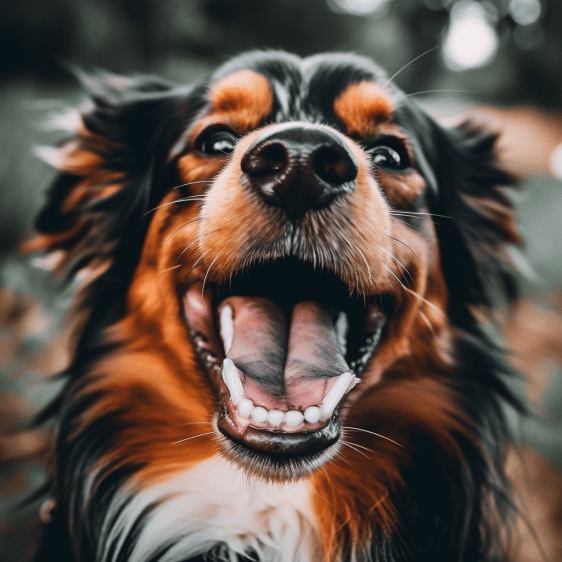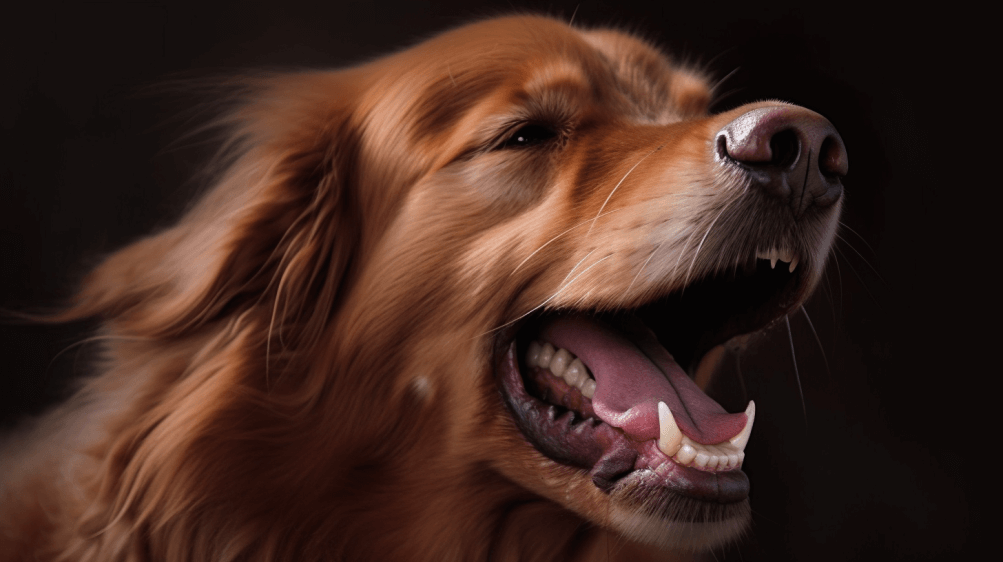As a dog owner, you’ve probably noticed that your furry companion often pants, especially after a playful romp or on a hot day. While panting is a normal behavior for dogs, it’s essential to understand why it occurs and when it might be a cause for concern.
In this post, we will explore the reasons behind your dog’s panting, how to differentiate between normal and excessive panting, and what steps you can take to ensure your dog’s well-being.
In the sections that follow, we will cover:
- Normal panting behavior in dogs: Learn about the various reasons dogs pant and how to identify what’s considered normal.
- Causes of excessive panting in dogs: Discover common and medical causes that may lead to increased panting in your dog.
- How to determine if excessive panting is a concern: Find out how to monitor your dog’s behavior and the importance of regular veterinary check-ups.
- How to help your dog if they’re panting excessively: Learn about immediate actions and long-term solutions to help your dog with excessive panting.
- When to seek professional help: Recognize the red flags that indicate it’s time to consult a veterinarian.
By understanding the nuances of your dog’s panting behavior, you can be a more attentive and responsible pet owner, ensuring your dog stays healthy and happy. Let’s dive in and explore the world of panting to provide the best care for your furry friend.
Table of contents
Normal Panting Behavior in Dogs
Panting is a natural behavior for dogs and serves various purposes. In this section, we will explore the reasons dogs pant, and how to identify what’s considered normal panting behavior.
Why Dogs Pant
There are three primary reasons dogs pant:
- Thermoregulation: Unlike humans who primarily rely on sweating to release excess body heat, dogs cool themselves down by panting. As they breathe rapidly, water evaporates from their tongue, nasal passages, and lining of the lungs, helping to lower their body temperature.
- Stress relief: Panting can also be a coping mechanism for dogs when they experience stress, fear, or anxiety. The rapid breathing helps them to self-soothe and calm down in difficult situations.
- Communication: Dogs may also use panting as a way to communicate with humans and other animals. For example, a dog may pant excitedly when they see their owner preparing to go for a walk, or when they are eager to play.
Identifying Normal Panting
It’s important to recognize the characteristics of normal panting in dogs to distinguish it from excessive panting. Here are some indicators of typical panting behavior:
- Occasional, even breathing: Normal panting is characterized by occasional and even breaths that are not labored or excessively rapid.
- Panting during or after exercise or play: It’s natural for dogs to pant during or after physical activity, as they need to cool themselves down and catch their breath.
- No signs of distress: When a dog is panting normally, they should not exhibit any signs of distress, such as wheezing, coughing, or difficulty breathing.
This table is a quick reference guide for possible reasons your dog is panting so much and what you might want to do:
| Reason for Panting | Possible Causes | Symptoms & Signs | What to Do |
|---|---|---|---|
| Heat | Hot weather, overexertion | Excessive panting, seeking shade, lying on cool surfaces | Provide cool water, move to a cooler area, avoid overexertion |
| Stress or Anxiety | Loud noises, new environments | Panting, pacing, hiding, whining, trembling | Offer comfort, use calming techniques, remove stressors |
| Pain or Discomfort | Injury, illness, or medical issue | Panting, limping, sensitivity to touch, changes in behavior | Consult your veterinarian, monitor your dog for other symptoms |
| Overweight | Excess weight affecting breathing | Panting, reduced activity, difficulty moving | Consult your veterinarian, implement a weight loss plan |
| Breed-related | Brachycephalic breeds (e.g. Pugs) | Panting, snorting, noisy breathing | Monitor for breathing difficulties, avoid overheating |
| Excitement | Play, greeting, anticipation | Panting, wagging tail, playful behavior | Engage in play or activity, provide opportunities to calm down |
Being aware of what constitutes normal panting behavior can help you better understand your dog’s needs and determine if there might be an underlying issue causing excessive panting. In the next section, we will discuss the potential causes of increased panting in dogs.
Causes of Excessive Panting in Dogs
While panting is a natural behavior for dogs, excessive panting may indicate an underlying issue that requires attention. In this section, we will explore common and medical causes that may lead to increased panting in your dog.
Common Causes
There are several common reasons that can cause your dog to pant excessively:
- Overheating: Dogs may pant excessively when they are too hot, either due to high environmental temperatures or overexertion during exercise. It’s essential to provide your dog with a cool environment and monitor their activity levels to prevent overheating.
- Anxiety or stress: Dogs that are experiencing anxiety or stress may pant more than usual as a coping mechanism. Common stressors include loud noises, unfamiliar environments, or separation from their owners.
- Pain or discomfort: Panting can be an indication that your dog is experiencing pain or discomfort. This could be due to an injury, an ongoing medical issue, or even something as simple as an upset stomach.
- Obesity: Overweight dogs may pant more frequently because they need to work harder to breathe and maintain a comfortable body temperature. Ensuring your dog maintains a healthy weight through regular exercise and a balanced diet can help reduce excessive panting.
- Breed-related predisposition: Certain dog breeds, such as brachycephalic breeds (e.g., Pugs, Bulldogs, and Boxers), are more prone to panting due to their short snouts and facial structure, which can make breathing more difficult.
Medical Causes
In some cases, excessive panting may be a symptom of an underlying medical condition:
- Heart problems: Panting can be a sign of heart issues, such as congestive heart failure or other cardiac diseases, which may cause difficulty breathing and decreased oxygen delivery to the body.
- Respiratory issues: Respiratory problems, such as asthma, pneumonia, or lung tumors, can cause increased panting as the dog struggles to get enough oxygen.
- Hormonal imbalances: Conditions like Cushing’s disease or hypothyroidism can lead to excessive panting due to hormonal imbalances that affect the dog’s metabolism and overall health.
- Neurological disorders: Dogs with neurological issues, such as brain tumors or seizures, may pant excessively as a result of changes in brain function.
- Side effects of medications: Some medications, like steroids or pain relievers, can cause increased panting as a side effect.
How to Determine if Excessive Panting is a Concern
It’s crucial to monitor your dog’s behavior and panting patterns to determine if there is cause for concern. In this section, we’ll discuss how to observe your dog’s behavior and the importance of regular veterinary check-ups.
Monitoring Your Dog’s Behavior
- Observing changes in panting patterns: Keep track of when and how often your dog pants, as well as any changes in their panting behavior, such as increased frequency or intensity.
- Noting additional symptoms or behaviors: Be on the lookout for other signs that may indicate an underlying issue, such as coughing, lethargy, loss of appetite, or difficulty breathing.
Importance of Regular Veterinary Check-ups
- Early detection of health issues: Regular check-ups with your veterinarian can help detect health problems early, allowing for more effective treatment and management.
- Preventative care: Routine veterinary visits also provide an opportunity for preventative care, such as vaccinations and dental cleanings, which can help maintain your dog’s overall health and well-being.
How to Help Your Dog if They’re Panting Excessively
If you notice your dog panting more than usual, there are several steps you can take to help them feel more comfortable:
Immediate Actions
- Providing a cool environment: Ensure your dog has access to a cool, shaded area, particularly on hot days or after exercise. You can also use fans or air conditioning to help maintain a comfortable temperature.
- Offering fresh water: Make sure your dog has access to clean, fresh water at all times to help them stay hydrated and cool.
- Removing stressors: Identify and remove any potential stressors that may be causing your dog’s anxiety, such as loud noises or unfamiliar surroundings.
Long-term Solutions
- Regular exercise and weight management: Help your dog maintain a healthy weight through regular exercise and a balanced diet. This can reduce the likelihood of obesity-related panting.
- Addressing anxiety or stress with training or medication: Consult with your veterinarian or a professional dog trainer to develop strategies for managing your dog’s anxiety or stress, which may include behavior modification, training techniques, or medication.
- Managing underlying medical conditions: Work closely with your veterinarian to manage any underlying medical conditions that may be causing your dog’s excessive panting.
- Seeking veterinary advice: Consult your veterinarian if you have concerns about your dog’s panting behavior, as they can provide tailored advice and recommend any necessary tests or treatments.
When to Seek Professional Help
It’s crucial to know when to consult a veterinarian if you notice concerning signs in your dog’s panting behavior.
Here are some red flags that indicate it’s time to seek professional help:
- Labored breathing or choking: If your dog’s panting is accompanied by labored breathing, choking, or gagging, it could indicate a serious respiratory issue.
- Pale or blue gums: If your dog’s gums appear pale or blue while panting, it may be a sign of inadequate oxygen supply, which requires immediate veterinary attention.
- Collapsing or extreme lethargy: If your dog collapses or exhibits extreme lethargy in conjunction with excessive panting, it may indicate a severe medical issue.
- Persistent panting despite a cool environment and rest: If your dog continues to pant excessively even after they’ve been provided with a cool environment and ample rest, it could signal an underlying problem that needs to be addressed.
Importance of Prompt Veterinary Attention
Seeking prompt veterinary attention when you notice any of the red flags mentioned above is crucial for your dog’s health and well-being. Timely intervention can help prevent complications, manage underlying conditions more effectively, and potentially save your dog’s life.
Why is My Dog Panting So Much? – FAQs
Here are some answers to common questions about excessive panting in dogs:
What is normal panting in dogs?
Normal panting occurs when dogs are hot, thirsty, or excited. It helps regulate body temperature and cool down.
Why is my dog panting excessively?
Excessive panting can be a sign of medical issues, such as overheating, anxiety, pain, respiratory problems, or heart disease.
How can I help my panting dog?
The best way to help depends on the cause of the panting. For example, if due to overheating, move to a cooler place and offer water. If due to anxiety, try to calm them down. If due to a medical issue, see a veterinarian.
Can panting be prevented?
Yes, panting can be prevented by ensuring good health and providing a comfortable living environment. Regular exercise and brain training for dogs can also help prevent panting. Check out our brain training for dogs guide.
What are other signs to look out for in my dog?
Other signs to look out for include hot skin, anxious behavior, signs of pain or discomfort, coughing, lethargy, and loss of appetite. If your dog shows any of these signs along with excessive panting, it’s important to see a veterinarian.
How can I bond with my dog and reduce stress?
Bonding with your dog can help reduce their stress and prevent excessive panting due to anxiety. Check out our guide on how to pet a dog for tips on building trust and strengthening your bond with your furry friend.
Are there any dog breeds that pant more than others?
Some dog breeds may pant more than others due to their body structure or physical characteristics. For example, breeds with short snouts, such as bulldogs, may pant more due to difficulty breathing. Check out our list of 10 weird dog breeds that look like bears for some unique breeds to learn about.
Can a pregnant dog also pant excessively?
Yes, a pregnant dog can also pant excessively. Check out our guide on how to tell if a dog is pregnant for more information and to learn about other signs to look for.
If you have any further questions or concerns about your dog’s excessive panting, it’s always best to consult a veterinarian. They will be able to provide a proper diagnosis and treatment plan to help your furry friend feel better.
Conclusion
Understanding the reasons behind your dog’s panting behavior is essential for being a responsible and attentive pet owner. By familiarizing yourself with the differences between normal and excessive panting, monitoring your dog’s behavior, and seeking professional help when needed, you can ensure your furry friend stays healthy and happy.
Remember that your dog relies on you for care and support, so always be proactive in addressing any concerns about their panting or overall health.



